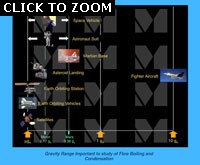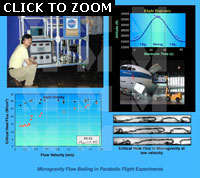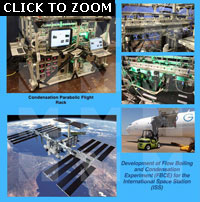Applications: Spacecraft Thermal Control
With projected increases in scope, complexity and duration of future space missions, both power and heat dissipation demands are expected to rise. Success of these missions will depend largely on the ability to reduce size and weight of all key thermal management sub-systems. One means to achieving this goal is to reduce surface area of heat exchange surfaces by replacing single-phase systems with two-phase counterparts, which can yield orders of magnitude enhancement in heat transfer coefficients. Small size and weight, minimal coolant inventory requirements, and ability to produce very high evaporation and condensation heat transfer coefficients, are all reasons why two-phase heat exchangers are expected to play a crucial role in future space mission.
 Space missions span a range of gravities. Microgravity is important to the operation of satellites and Earth orbiting vehicles and stations. Future space missions will also demand strong understanding of the influence of Lunar and Martian gravities. On the other hand, thermal systems in fighter aircraft must be able to handle relatively large body forces. In the presence of any gravitational field, large density differences between liquid and vapor induce buoyancy effects. Therefore, magnitude of gravity can have a significant influence on two-phase flow and heat transfer, especially critical heat flux (CHF).
Space missions span a range of gravities. Microgravity is important to the operation of satellites and Earth orbiting vehicles and stations. Future space missions will also demand strong understanding of the influence of Lunar and Martian gravities. On the other hand, thermal systems in fighter aircraft must be able to handle relatively large body forces. In the presence of any gravitational field, large density differences between liquid and vapor induce buoyancy effects. Therefore, magnitude of gravity can have a significant influence on two-phase flow and heat transfer, especially critical heat flux (CHF).
 Mudawar’s team has performed FC-72 flow boiling experiments in microgravity, Lunar gravity (0.16 ge), and Martian gravity (0.38 ge), conditions that were produced during parabolic maneuvers aboard NASA’s KC-135 turbojet and Zero-G Corporation’s Boeing 727-200. Vapor behavior was monitored along heated walls of a rectangular channel with the aid of a high-speed video camera. These experiments showed drastic differences in CHF data between Earth gravity and microgravity. While the effect of velocity on CHF in Earth gravity is relatively mild, CHF at low velocity in microgravity is only 50% that in Earth gravity. But the effects of buoyancy become negligible when velocity is increased to 1.5 m/s, at which CHF values for both gravities converge. This convergence has important practical implications to design of space thermal management systems since, by knowing the velocity at which such convergence occurs, designers may be able to utilize the vast body of knowledgeamassed from celestial two-phase studies to design reduced gravity thermal management systems with confidence, provided flow velocity exceeds the convergent value.
Mudawar’s team has performed FC-72 flow boiling experiments in microgravity, Lunar gravity (0.16 ge), and Martian gravity (0.38 ge), conditions that were produced during parabolic maneuvers aboard NASA’s KC-135 turbojet and Zero-G Corporation’s Boeing 727-200. Vapor behavior was monitored along heated walls of a rectangular channel with the aid of a high-speed video camera. These experiments showed drastic differences in CHF data between Earth gravity and microgravity. While the effect of velocity on CHF in Earth gravity is relatively mild, CHF at low velocity in microgravity is only 50% that in Earth gravity. But the effects of buoyancy become negligible when velocity is increased to 1.5 m/s, at which CHF values for both gravities converge. This convergence has important practical implications to design of space thermal management systems since, by knowing the velocity at which such convergence occurs, designers may be able to utilize the vast body of knowledgeamassed from celestial two-phase studies to design reduced gravity thermal management systems with confidence, provided flow velocity exceeds the convergent value. 
Recently, Mudawar’s team has performed extensive additional flow boiling and condensation experiments in both Earth gravity and parabolic flight as a prelude to development of NASA’s Flow Boiling and Condensation Experiment (FBCE) for the International Space Station (ISS). The condensation experiments were focused on annular condensation of FC-72. The flow behavior of the condensate film was shown to be highly sensitive to mass velocity, with low mass velocities yielding laminar flow with smooth interface, and high mass velocities turbulent flow with appreciable interfacial waviness. A select number of tests repeated in microgravity, Lunar gravity, and Martian gravity proved the influence of gravity is very pronounced at low mass velocities, manifest by circumferential uniformity for microgravity versus appreciable thickening along one side of the condensation tube for Lunar and Martian conditions. However, the thickening is nonexistent for Lunar and Martian conditions at high mass velocities due to increased vapor shear on the film interface, proving high mass velocities are an effective means to negating the influence of gravity on condensation in space missions.
